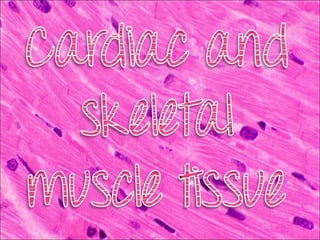Cardiac and skeletal muscles1
•Descargar como PPT, PDF•
2 recomendaciones•1,985 vistas
presentación sobre el músculo cardíaco realizada por Laura.
Denunciar
Compartir
Denunciar
Compartir

Recomendados
Recomendados
Más contenido relacionado
La actualidad más candente
La actualidad más candente (20)
Nervous control of blood vessels regulation of arterial pressure

Nervous control of blood vessels regulation of arterial pressure
Destacado
Destacado (20)
Anatomy & physiology of neuromuscular junction & monitoring

Anatomy & physiology of neuromuscular junction & monitoring
Chapter 5 Enzymes Lesson 1 - Introduction to Enzymes

Chapter 5 Enzymes Lesson 1 - Introduction to Enzymes
Similar a Cardiac and skeletal muscles1
Similar a Cardiac and skeletal muscles1 (20)
2. Unit - 7-Muscles Anatomy, Thiru Murugan, Msc Professor

2. Unit - 7-Muscles Anatomy, Thiru Murugan, Msc Professor
Cardiac and skeletal muscles1
- 2. Cardiac and skeletal is muscles Cardiac muscles: a type of involuntary Striated muscle found in the walls of the heart specially in the myocardium. Myocardium
- 3. Cardiac muscles Main types of cells: - Myocardial cells: Make up the artrium (the chamber in which blood enters the heart) and ventrical (where blood is pumped out of the heart) of the heart. These cells are necessary to the beating of the heart.
- 4. Cardiac muscles Main types of cells: Heart Cell - Electrical cells: -They carry the impulses that are responsible for the beating of the heart. - Responsible for several functions, like generate and send out electrical impulses and receive and respond to electrical impulses from the brain.
- 5. Cardiac muscles Structure of cardiac tissue - Cardiac muscle fibers are striated, branched, and have a single central nucleus. These cells are attached at their ends to the fibres by thick plasma membranes.
- 6. Cardiac muscles - Structure of Cardiac Tissue
- 7. Cardiac muscles - The types of tissue: - Endocardium - Myocardium - Epicardium
- 8. Cardiac muscles • Endocardium The endocardium is the smooth layer of tissue that lines the walls of the heart. It has a shiny surface that allows blood to flow freely. Endocardium
- 9. Cardiac muscles • Myocardium The myocardium is the thick, muscular, middle layer of the heart. This layer is responsible for contracting the heart and sending blood to the body tissues. Myocardium
- 10. Cardiac muscles • Epicardium The epicardium or outer layer is a thin layer that serves to support in place and protect the heart.
- 11. Cardiac muscles Organ: We can find cardiac muscles tissues in the heart.
- 12. Cardiac muscle - The functions: Pumping of blood through the heart: Alternate contraction and relaxation of cardiac muscle pumps
- 13. Cardiac muscles • Infectious Diseases of the Heart - Some infectious diseases cause inflammation of one of the cardiac tissue layers, resulting in permanent heart damage. A virus or type of bacteria typically causes these conditions.
- 14. Skeletal muscle tissue Skeletal muscle tissue: It’s a type of striated muscle that allows to do voluntary physical movements of all types.
- 15. Skeletal muscle Main types of cells: Skeletal tissue is mainly made up of myocites. The cells that make up skeletal muscle tissue are Tissue long and fibrous. Myocyte
- 16. Skeletalmuscle tissue Structure of skeletal tissue:
- 17. Skeletal muscle We can find tissue skeletal muscle tissue in the muscular system.
- 18. Skeletal muscle tissue Functions of skeletal tissue: - Skeletal tissue work in pairs to coordinate the movements of the limbs, trunk, etc. - They are directly involved in breathing.
- 19. Skeletal muscle tissue Diseases of the skeletal muscle: Fibromyalgia is a disorder that causes muscle pain and fatigue. People with fibromyalgia have "tender points" in the body. Tender points
- 20. Cardiac and skeletal muscle tissue • Questions: 1. What is the main difference between cardiac and skeletal tissues? - Cardiac tissues are involuntary and skeletal tissue is voluntary. 1. What is the main function of the cardiac muscle tissue? - Pumping blood through the heart.